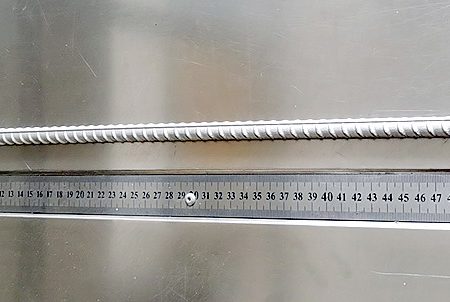AREMA (American Railway Engineering and Maintenance-of-Way Association) a plusieurs normes ferroviaires, Ces normes couvrent divers aspects des rails ferroviaires, telles que les dimensions, Propriétés des matériaux, Procédures d’essai, et exigences d’installation.
AREMA comprend plusieurs types de rails en acier, which are classified based on their weight per yard (or meter) and the type of steel used. The most common types of steel rails specified by AREMA are:
115 Rail RE: This is a standard rail with a weight of 115 livres par verge (57.1 kg/m). It is made of carbon steel and is commonly used in mainline tracks.
136 Rail RE: This is a heavier rail with a weight of 136 livres par verge (67.4 kg/m). It is also made of carbon steel and is used in high-traffic areas, such as curves and turnouts.
Other types of steel rails specified by AREMA include 90RA, 100 RE, 132 RE, et 175 LB crane rail, entre autres. These rails have different weights and are made of different grades of steel to meet specific requirements of various railway applications.
The rail of AREMA is used in railway transportation infrastructure, including rail tracks, switches, crossings, and other components. It is commonly used in North America for both freight and passenger rail systems.
The rail of AREMA is primarily used in South America and North America, particulièrement aux États-Unis et au Canada. Toutefois, it may also be used in other parts of the world where American standards are adopted for railway infrastructure.
AREMA has established several standards for railway fasteners used in railway infrastructure. Some of the common railway fasteners specified by AREMA include:
Rail clips
Rail anchors
Elastic rail clips
Tension clamps
Rail bolts
Fish plates or splice bars
Tie plates
Rail pads
Pointes à vis
Dog spikes
These fasteners are designed to securely attach rails to sleepers or ties, Assurer la stabilité, sécurité, and longevity of the railway systems.
The installation of rails in accordance with AREMA standards requires a specific process. Here are the general steps involved in installing rails according to AREMA guidelines:
Préparer le site: The site must be cleared of any debris or obstructions that might interfere with the installation process.
Position the sleepers: The sleepers or ties must be properly aligned and spaced according to the design specifications.
Position the rails: The rails must be laid out on top of the sleepers, ensuring that they are properly aligned and spaced according to the design specifications.
Fix the rail fasteners: Once the rails are in position, the appropriate AREMA-approved rail fasteners must be used to secure the rails to the sleepers.
Tension the rails: The rails must be properly tensioned to ensure that they remain securely attached to the sleepers.
Torque the fasteners: The fasteners must be torqued to the appropriate specifications to ensure that they remain tight and secure.
Test the rails: Finalement, the rails must be tested to ensure that they meet the specified tolerances for alignment, gauge, and curvature.
Bienvenue à nous demander les rails de fond plats standard internationaux comme ci-dessous:





